
The First Trinity Church
By 1818 the Lenox Anglican community had finally amassed the funds to complete its first church. It was in the center of the village at 33 Church Street.
It was consecrated Sept. 7, 1818 by Bishop Alexander Viets Griswold. The bishop was a nephew of the first Anglican priest to visit Lenox, Roger Viets (probably 1763).
The white wooden church was described as Gothic Revival or Carpenter Gothic. The stylistic indicators include the window shape and the steeple parapets. This may have been an early example of the style common in New England in the 1830-1850 period.
In 1873 a new chancel and transepts were added.
When the new Trinity Church was built at Walker and Kemble, the old church building was purchased by parishioner L.C. Peters and stands (without its spire) on Church St. today.
Trinity became the legal name of the congregation in 1918 but there is reference to “Trinity Church” in the 1819 vestry records.
The Episcopalian Church in Lenox Struggled in Mid 19th Century
The consecration must have had some interesting interpersonal chemistry since the rector at the time, Samuel Griswold was the brother of Bishop Griswold and was dismissed ten days later!
After Rev. Griswold’s departure, only one dedicated Lenox rector for (1840-1844-Rev. George Waters) is listed in John Allen Gable’s history. For the rest of the time, services were shared with other parishes and revenue was supplemented by the missionary society.
In 1832 only 18 adult members were listed. and by 1850 services were only held occasionally. The absence of a regular rector certainly contributed to the fall off in membership but undoubtedly was not the only factor. During the first half of the 19th century, new Episcopal parishes proliferated. Ironically, they included (Pittsfield, Stockbridge, Otis and others) towns that had spun off from early worship in Lenox. At that time the pulpit at Church on the Hill was manned by the very popular Rev. Shephard. Also, it was the era of revivals and new sects to the area — including the addition of a Methodist church that was established down the street on the now aptly named Church St.
As with many churches then and now, the flame was kept burning by a few dedicated volunteers. One, Debby Hewes Quincy, is singled out with a plaque in the current Trinity Church.
Several other factors contributed to turning things around for the little Trinity congregation. Bishop Manton Eastburn wanted a strong priest in Lenox to turn back the tide of Unitarianism. Also, train service was now available and the early generation of wealthy summer visitors (frequently Episcopalians from New York) had started to arrive. Finally, a popular priest, Thomas Pynchon led the congregation from 1850-1854. A quote from Charles Palmer’s early history of Trinity paints a picture of his interaction with a particularly demanding visitor:
“As he went out of the church he (Mr. Pynchon)saw a figure seated on the steps. It arose as he approached, and shaking a forefinger at him said in a very deep and impressive voice: ‘Your music is execrable, execrable! If you will have the organ sent to Pittsfield for repairs and tuning, I will pay for it.’ The seated figure was Miss Fanny Kemble. She became a regular attendant at the services, a liberal contributor, and a warm personal friend of Mr. Pynchon.”
Despite the popularity of Mr. Pynchon and several other well thought of but short term priests (Rev. William Henry Brooks, Rev. Henry Albert Yardley), the Lenox continued to struggle and Lenox again required missionary aid.
Leadership of Rev. Justin Field
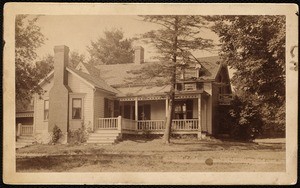
The full potential of the resident and visiting Anglican congregation was achieved under the leadership of the long-serving Rev. Justin Field who was rector 1862-1890.
Construction of New Trinity Church, Rectory and Chapel
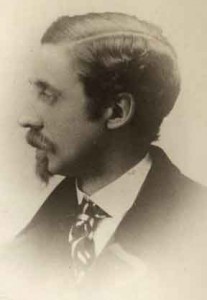
The first official mention of a new church building is found in 1882. The building effort was led by architect, philanthropist and church warden Colonel Richard Tylden Auchmuty.
The church purchased the triangle formed by Kemble and Walker (known as Lyman’s corner – for – according to maps of the time – the location of the Lyman’s residence/ store).
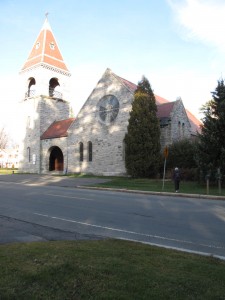
The building committee hired McKim, Mead and White and, like any other self respecting church committee proceeded to dabble. Five designs later the very handsome result reflect some McKim, some Auchmuty and some Renwick (a friend and associate of Auchmuty’s).
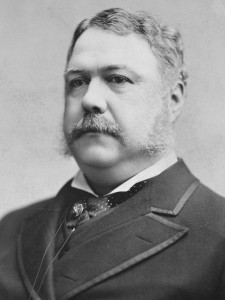
The cornerstone was laid September 8, 1885 by former President Chester A. Arthur. Arthur’s Secretary of State, Theodore Frelinghuysen from New Jersey had built the lovely Georgian “cottage” across the street in 1881. A plaque honoring the 21st President stands in Trinity today.
The new church was consecrated June 19, 1888 and was filled with Tiffany windows and other elaborate furnishings donated by a who’s who of wealthy summer visitors.
The church interior as of 2016 reflects substantial additional decoration and re-staining in the 1920’s
Undeterred by having spent three times their budget on the church, the parishioners proceeded to construct a handsome rectory in 1892 and a chapel in 1896.
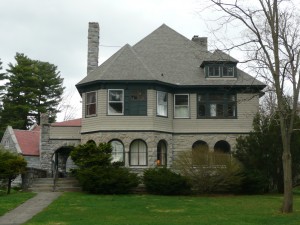

At last the wealthy visitors had a place of worship consistent with their gilded age “cottages.”
St. Helena’s
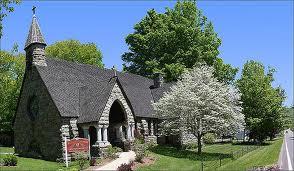
Originally called the Union Chapel, the New Lenox Episcopal Church was completed in 1893. Later called St. Helena’s, it was donated by John E. Parsons in honor of his daughter, Helen Reed Parsons.
Mr. Rathbun is referenced as the architect in a Pittsfield Sun article. Mr. Rathbun was also thought to be the architect of the Church on the Hill Chapel on Main St.
In the then thinly settled New Lenox, the chapel’s use was highly ecumenical with Rev. Grosvenor conducting services two Sundays a month, the Methodists on another and the Baptists on a fourth.
St. Helena’s remained a part of Trinity Church until 1980 when it was established as a separate parish. The two churches have just completed an agreement (2016) to share services.
Trinity Rectors 1801-1895
Samuel Griswold (1801-1818)
(1819-1820 – Rev. George Thomas Chapman served Lenox, Lanesborough and Great Barrington)
Aaron Humphrey (1820-1825)-one Sunday a month, the rest of the time in Lanesborough
Benjamin C.C. Parker (1826-1832) – also Otis
Samuel P. Parker (1834-1836) – also Stockbridge
(1836 Rev. Mr. Walcott of Stockbridge conducted services in Lenox)
George Waters (1840-1844)
(1845 Rev. George Thomas Chapman – again conducted some services in Lenox)
Samuel T. Carpenter (1846-1847)-of Van Deusenville – one Sunday a month in Lenox
F.A. Foxcraft (1848-1849) – of Van Deusenville – conducted some services in Lenox
Thomas Ruggles Pynchon (1850-1854)
William Henry Brooks (1855-1856)
Samuel P. Parker (1857-1859) – also Stockbridge
Jesse A. Penman (1859-1861) Samuel Parker’s assistant
Henry A. Yardley (1861-1862)
Justin Field (1862-1890)
William Mercer Grosvenor (1890-1895)
__________________
Sources of Information
History of Trinity Church, Lenox, Massachusetts, 1763-1895 by Rev. Charles J. Palmer, John Wilson and Sons University Press, Cambridge, 1895
The Goodness That Doth Crown Our Days, A History of Trinity Parish by John Allen Gable, Lamb Printing, North Adams, MA, 1993
